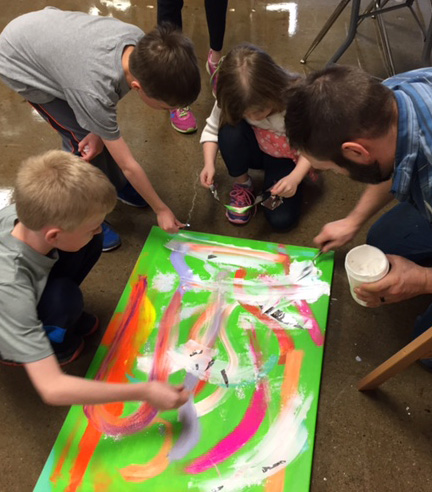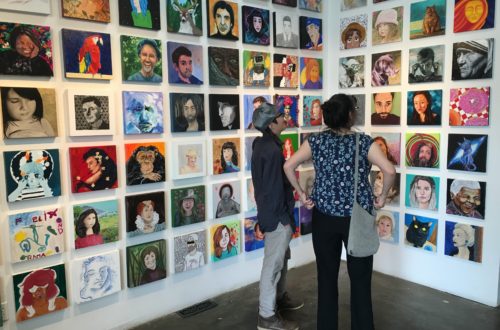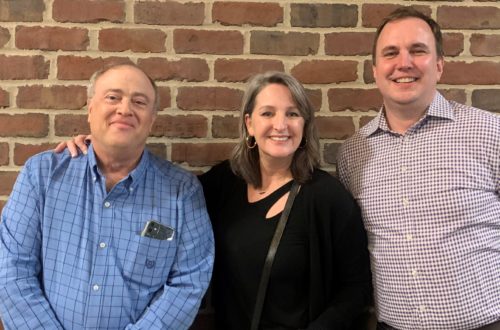Every year Plaza Art throws an event at four of their store locations that is part festival, part art-party, and part workshop: Hands on Creativity (HOC). For an entire weekend, customers participate in free art demonstrations, meet artist representatives from major art brands and return home with rejuvenated creative spirits, not to mention bags bursting with treasure troves of free samples. This feel-good annual event brings in business, builds community and has been in action for nearly ten years. In the interest of discovering what the Plaza team has learned over time and discovering the positive impact that these kinds of art extravaganzas can have, we reached out to Bruce Baker, who has been the point person for Hands on Creativity in Nashville, Tennessee for the past 8 years. Bruce was more than happy to chat about his favorite (albeit busiest) weekend of the year.
How has Hands on Creativity (HOC) grown and evolved over the years?
“HOC was a collaboration of Eric Zelenko, Tara Walsh and myself. It started off kind of small, featuring several major vendors: MacPhersons, ColArt, Winsor Newton, Liquitex, Golden, Strathmore. We have about 15 workshops and classes that we offer in our store that meets here every week, and the first time we did HOC we invited some of our regular instructors to be a part of it as well, connecting them with those manufacturers. Now we really don’t have any more room to fit anyone else in: last year we had 38 tables!
As for evolving, we’ve gotten a lot smarter. I reach out to local art organizations and connect them with the vendors that are right for them. The Tennessee Watercolor Society has a table, and I pair them up with Daniel Smith watercolors. They do a make and take, Winsor Newton provides paper, Princeton provides the brushes. Everybody is helping everybody.”
How did you build the partnerships and connections that are now present at HOC?
“A lot of collaboration. In the past, a manufacturer’s rep might come to visit me, they say hey, I’m going to be in your store in two weeks. People with all this incredible working knowledge, and they sit down and show me catalogues and discounts. That’s useless to me. I’m not a buyer like I used to be. We are always looking to engage, and now, for instance, when the person who represents Speedball, Stacy Kelly tells me she’s coming, I email our marketing team: send out an eBlast we’re going to do a mini Speedball printing class for free! Hands on Creativity is that interaction, but on a larger scale. The Tennessee Watercolor Society didn’t used to buy a lot of stuff here, now they do. I said to them, I have free classroom space, why don’t you use it and then participate when HOC comes around? I invite anybody who is art related. We compensate them with product.”
How far ahead to do you plan for HOC?
“I plan it a year in advance: I reserve people for that date, I start talking to my local group and instructors. If you are a customer, it’s in our workshop schedule that we mail out, probably about 4 – 5 months in advance. People now know and ask about it. We have pre-workshops beforehand, too.”
What has been the most challenging aspect of planning HOC?
In the beginning, the challenge was trying to get everybody together. And trying to convince people to do this for free, that was tough. I went to all my teachers and said, listen, you’re teaching classes here. I don’t charge you for the room… we can’t pay you, but will you do something for HOC? Now that it is more established, people want to be a part of it. They call me to make sure they are on the list.
What is staffing like?
“It’s all hands on deck. I don’t get much sleep those three days. Everybody is worn out when we’re done…It’s a weekend event, and everyone knows it’s coming. It’s very quiet the day before, which gives us a lot of time to set up: that Friday morning we start “destroying” the store. On Monday we have the opportunity to clean up the store and return it to its original form.”
What is HOC like the day of?
“It’s kind of like if you are at a rock concert, sports event or hockey game. I call it managed art chaos. Logistics-wise, we have 47 parking places, but we have good neighbors and we borrow their parking lot. All the product is pushed against the walls and there are tables all throughout the center of the store. We open up at 8:30 and we have free classes. Daniel Smith did a watercolor demonstration last year. It’s a circus of art supplies, it’s free, and everyone there knows what they are talking about. Manufacturers with free samples, local artists demonstrating what they do, or a combination of both. If customers time it right, they can leave with about 100 free samples, goodie bags, mini pads. We also have a big sale, 40% off everything we can. A lot of people come back the second day. The feedback is really good.”

What’s the feedback you’ve gotten from vendors?
“Vendors really like it because they get to show off their product. They get to meet the instructor, who influences so many with their expertise. Some classes, if teachers tell students to buy purple toilet paper with white polka dots, they’ll buy it. That’s powerful. Vendors can give samples and find out who these influencers are.”

How is this event sustainable / profitable for you?
“We usually do a little over 700 customers in two days. That’s 700 people through the door. All these potential customers who have never tried watercolor or a brush or a particular technique. If someone sees the price on a Sennelier oil stick, it’s three and a half dollars… that’s a lot of money. But if they sit down and make something with it, they see it as valuable, and worth their money. People buy things the day of the event, and it all rolls over during the weeks after, too.

All my instructors that teach here, they are at HOC as well. They are building a relationship with the vendor, and now these teachers can influence 36 students each. If they are buddy-buddy with the manufacturer… guess what the students are required to buy to be in the class? These connections make HOC a huge success.
Lastly, people want the experience. They might still do a lot of business online, but they also want to come in and touch and see, and have a conversation. HOC provides that experience.”
How exactly is HOC valuable to your customers?
“We thought about changing the name to Customer Appreciation Day. We appreciate our customers, and HOC is education. Let them play and try anything that they may not have ever tried. Maybe they are an acrylic artist but they’ve never tried oil…HOC is a way to come and explore and find out what you like and don’t like. You can leave your wallet at home it doesn’t cost you a dime. Nobody actually leaves their wallet at home though!”
Why October?
“People are starting to get in the holiday spirit. HOC is a dose of really good positive energy; people don’t have to pay a fee. They don’t have to buy something and go home and figure out if they like it. If they have a problem they want to vent about, someone is there to listen to them and even troubleshoot. HOC is a great way to introduce new products and meet new customers.”
What’s the most rewarding part of doing this yearly event?
“The positive feedback. The energy. It’s like filling up my gas tank. People come out and thank me, give me a hug. Manufacturers and customers alike, I hear it for months afterward. People come in and thank me, they send notes, emails… it’s a feel-good thing!”
Key Takeaways
Bruce’s experience spearheading Plaza’s Hands on Creativity in Nashville demonstrates that while there are challenges when it comes to orchestrating a big event, the rewards of investing in an annual weekend-long festival outweigh initial struggles. When you create a safe space for customers to explore, appreciate and learn, you catalyze their potential, engaging with a wider audience than ever and strengthening the arts scene in your community. Yes, the build up can take time – even years – to personally make connections and nurture relationships. But if you have an idea, the space and a handful of staff or instructors who are interested in making it happen, you’ve got plenty of potential waiting in the wings. Start small and keep the faith: an annual art event may be something your community is craving, and you’ve got the tools to get started!






